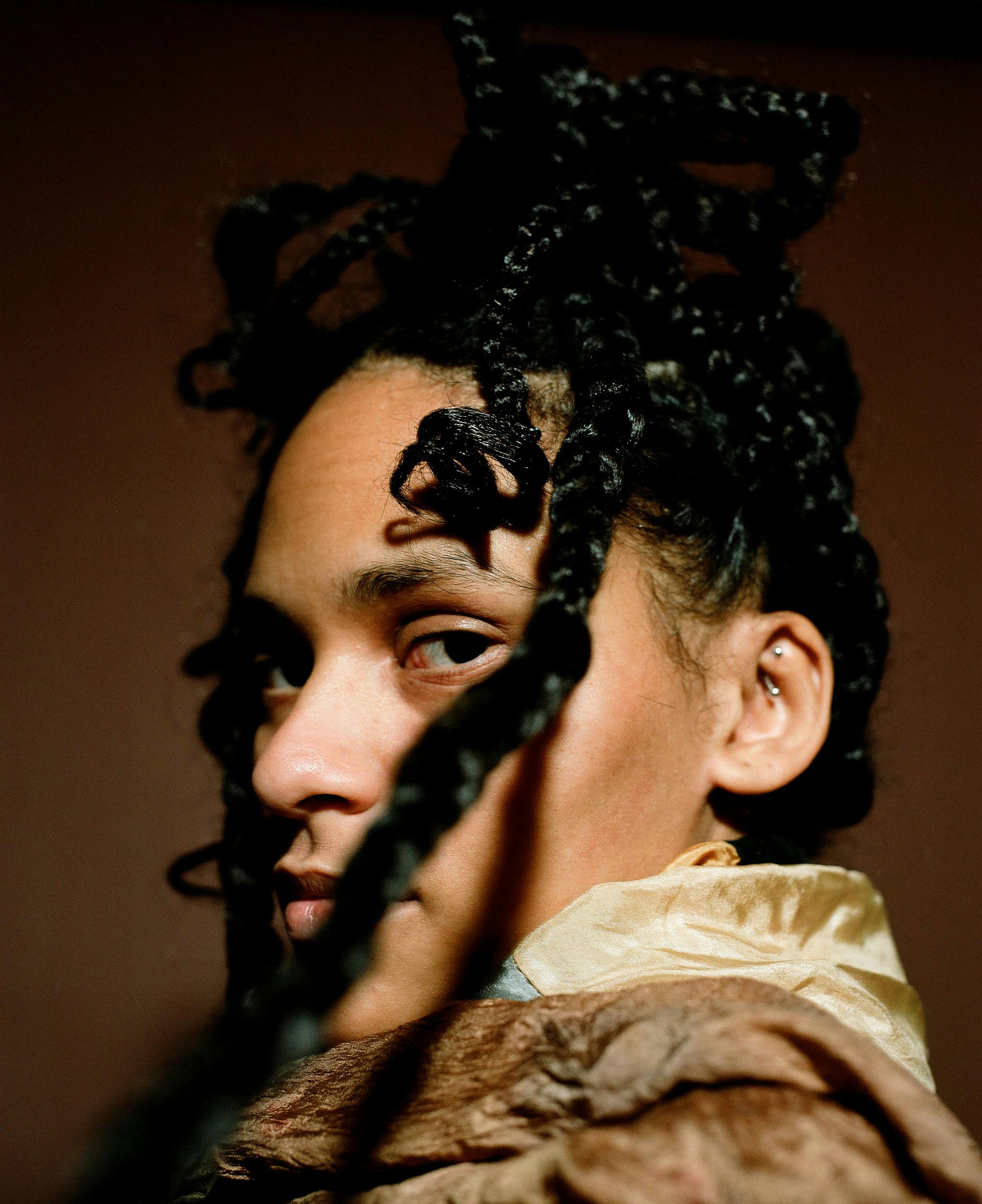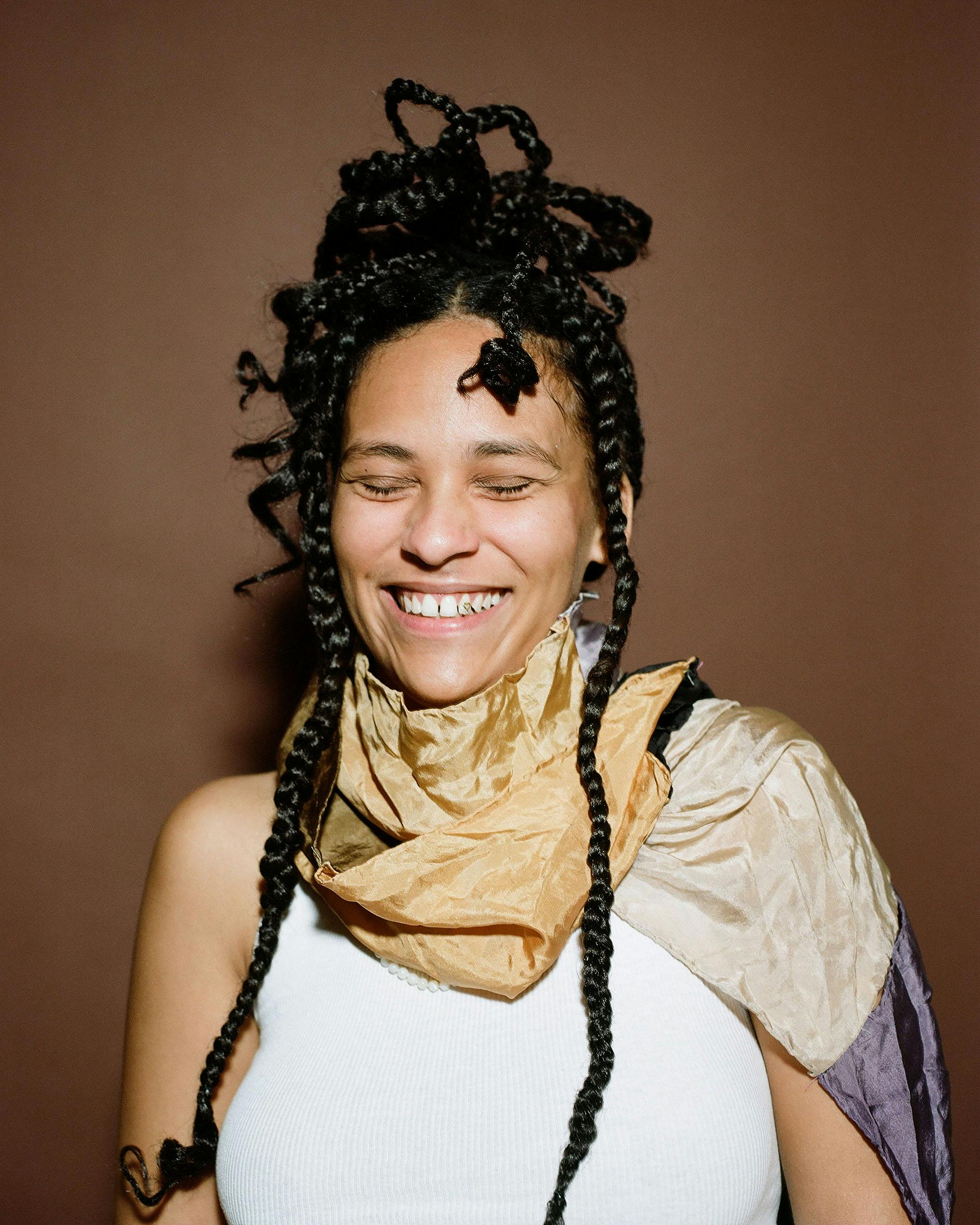
A Path That Calls Blue
Bridgette Hickey in conversation with Erika Nathanielsz
Photography by Paisley Lee
Installation Photography by Amber Capwell
The experience began with a single bell. The artist, Bridgette Hickey rang a silver handbell as the entire crowd went silent. Something about this gesture felt intimate and inviting, so many people in the audience, including myself, decided to sit on the ground. We wanted to listen. Bridgette walked through their installation of woven fabrics, mirrors and words, sometimes pausing, sometimes looking up at their work, as if they were listening too. Moments passed, and Bridgette sat in front of the crowd, paused, and recited their poetry.
I spoke with artist, weaver, poet, and medical anthropologist Bridgette Hickey about their process, holding space, and listening. Although Bridgette is creating across mediums, there is a connectedness to their work.
E: I saw your installation at the Omens of Capacity Show at Oregon Contemporary. Can you tell me about your process of creating the installation?
B: Well, I guess the first thing to talk about is how it came to be. I was invited to be a part of the show, it’s the first gallery show I’ve been a part of. Research is a core part of my work. It’s a somatic process including movement, writing, listening to the land, to the past, with water and bone as conduits for travel. My work has always been fairly ephemeral, so the challenge to put it into a form was something I felt nervous but also excited about. In the end, I think it came down to trusting myself as the student and the professor of my life. I had to set aside fears around my language differences and imagined separation.
This being my first installation, I had to trust returning to my own original forms of communication. The installation was a movement towards preciousness; that my story and my own learning process is one that’s valuable.
For the making, I had this clear mental snapshot of what I wanted to make, and I started sketching it, which is quite different from my typical processes. A part of the trust was moving forward with this internal snapshot of my landscape and turning it into something physical. I don't have it with me here, but it would be fun to show the very first sketches of it.
E: I’d love to see that. What does your creative process usually look like? What guides your practice?
B: Usually my making is very improvisational. I’m living and listening, which makes it possible for the container to come through. I have a moment in creating where it’s telling me, ok, it wants to be this. My process is a practice of how I attempt to keep myself well, and it is an accumulative one. I walk when I can or put myself outside. On days when I can’t leave the bed, there's always dreaming and window gazing. I need the relationship I have with the earth and with singing, and with writing to be able to listen, hear, witness the stories and the fragments that go into my archive. I hear words when I walk. I see images and stories fall out when I stretch and move. The plants I am tending give me song.
My practice is about protecting and widening the pathway of what is sacred. It’s about remembering and orienting my attention towards lifeways that protect life often by intimately honoring the dead and fragmented. I collect memories coming to the surface; they are the maps that I follow. It’s trusting being on a different time. It’s not urgent, but it knows that slowing down will bring integrity and quality understanding sooner than the other ways of immediacy. It’s a trust and intimacy with the unseen, it’s company with the choruses. It’s trust in the teachers of the universe.
E: Who are your teachers?
B: My teachers are oak, maple trees and willow. These are my earliest protectors and guides. The cellular waters of my body, and their ability to tune and return to the waters of earth. Lately, the process of rock and bone formation and erosion are deep witnesses to my practice, and they feel like mentors. The fairies, the unseen, death, and what’s left over. My heart is my teacher, and my hands they’re what know the most. Sound is a teacher and the way it can operate, flood, and inform. Folk story, ancestral, Black, Irish, and Indigenous craft.
E: Tell me about your relationship with words. When did you start writing poetry?
B: I grew up being told about the power of spoken and written words. Words were taught to me as prayer, as keys, or tools that could give and take life. In school, I struggled with how they wanted to train my livingness through language. I think I’ve always been writing poetry and understanding words through feeling and trust. I began to lean into and trust my words and formulations when they fell out from me. I was and continue to be curious about the maps and time spiral that they conduct.
Before I left school, I spent a summer doing research in a classical Chinese Medicine clinic. Here, there were beautiful words that depicted life and brought into the room textures, dreams, sensations, and beliefs that stretched beyond the confines I had known in other institutions and daily life. The words held the truth of everything it could mean to live in a body with extreme trust in what the body knew. Language here was also largely exchanged without verbal words. This was powerful for me because I am partially nonverbal. It was the way a room was oriented, it had to do with a quality of listening and exchange between bodies. Fingertips listening to blood. Using the body as a vessel. It placed language back to the source where it belonged and could have grounded lived origin.
I THINK A PART OF MY PRACTICE REALLY IS ME MAKING SPACE TO BE WHO I AM.
My practice is all of the things that institutional learning never was, and tried to take out of me. I talked to one of my older cousins and they were talking to me about their mom. They told me, “When we were little, my mom sat us down and taught us how to have manners with the ghosts that were coming in” So I’m like, it is about me, but I cannot also pretend like what I'm doing and experiencing doesn't have a huge history of sense-making and life-making. And is beyond me and beyond colonization too.
E: I love the synchronicity that happens with you between movement and nonverbal actions forming into words.
B: That’s a big part of what the purpose of language and words are to me. In the clinic, I felt fed and strengthened and would write things that people may call poetry. Poetry, for me, is a way of listening back, back to time, my body, and often many others who are there with me. My words become most available when I am doing any kind of movement. Sometimes, when I am dancing, and stimming, doing repetitive motions, they arise out of my body. I can hear them, and keep a notebook close to empty them into. There’s a big experience between words and their availability to me and a falling quality that happens. Words and conversation often come through while I am quilting and dyeing and weaving. It’s praying in tongues, it's hearing memory, its communion, it's why I do it all. I am given words in dreams and stories. I take it all with a serious curiosity. I am devoted to curiosity about what is here and to listening. To all the way it may be possible to be in an exchange. That is fascinating to me, especially as someone who can experience verbal exchange with humans too fast.
E: A chord that I’m hearing through everything you’re saying is the act of listening. Whether that’s to your own intuition or something bigger. I think your work also helps act as a vessel for people to pause and listen more. I definitely felt that happening during your show.
B: Yeah I think it would also be important to bring up care. Care is a big part of my practice. I think it’s also why I’m so devoted to my practice and it being the way that it is guided, because a lot of my family members had different abilities or disabilities. Or were these really powerful people who didn’t have the right support, or didn’t get to experience their own psyche in a beautiful way. And so I feel like a lot of it is me caring for the lineage for people with, quote-unquote, learning disabilities. There are a lot of autistic people in my family, including me, where there was no space to be cared for. So I’m very intentional about the way I bring my people in to experience this with me.
E: I can’t wait to see what you create. And for my last question, what does the color blue mean to you?
B: When I think about how it has come into my writing, it arrives again and again. It feels undeniable and is also something I have to have faith in. I think that the color blue is something that I'm in a lifelong process of understanding what it means. It's like some entity that holds a lot of direction, and that can feel consuming. Indigo, specifically the plant Indigo has such a magnitude to the history of the indigo plant, and colonization.
Something that I think is really special is on my mother's side, my grandpa grew up in a Black commune in Virginia, where they tended the land and animals. And the mud there is blue. It felt like some kind of remembering.
BLUE IS A QUESTION. IT'S AN ENTITY THAT'S AN EVERLASTING QUESTION.

The bone blue well of time holding time holding mineral holding hallway of blue holding echoes holding shadow density pulse pull through sponge core rupture rebuild reabsorption netted basket of
Lotus flowers and family rings we cast in threes.
Lotus flower lily pad we throw circles and plead for coverage
Lotus flower lily pad water moss thickened rock
Your girth has grown from the mucky threads that float by catching that which try to float through
It’s important to know the faces whose faces are you wearing?
What story are you re-enacting?
Or attempting to heal?
Whose face are you wearing that knows what’s happening to you?
That picked up purpose in the well?
That knew bone pain and marrow loss ?
Who’s face from
A time traveler
A warrior
Warrior of threes
And kings
Where the moss was prevalent and lush and rain constant
A home longing face longing lost longing what longing happened to us?
